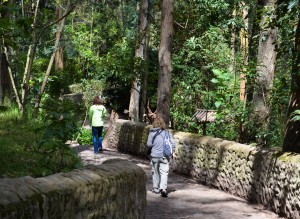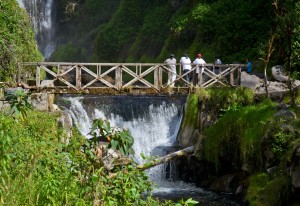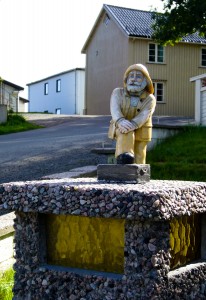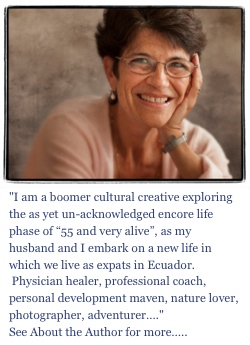You want to take a mountain hike, and fortunately there’s a trail map showing you several options. Which do you take? 
There are always two ways to journey. One is to have a destination and choose a path that will take you there. Or you can simply meander in a less purposeful way, enjoying whatever shows up along the way. Neither one is better or worse. In fact, I like both modes when I’m just out for a hike for a few hours.
But in life, the two modes are not equal. If you’re simply here (in life, that is) to enjoy the ride, the second is actually easier because you can change direction or go to another path if the going gets too tough or you sense it’ll take too long.
However, if you have a destination the odds are hugely increased that you’ll get there if you know there’s a path that takes you there. Likewise, if you know what path you’re on, you’ll also know when you’ve wandered off it. But most importantly, while following a path won’t guarantee that you’ll reach the destination you might have originally imagined, dealing with whatever challenges and inconveniences arise, you will more certainly accrue a wealth of personal development that you won’t when you’re just meandering.
This will include everything from a sense of purpose, to greater discipline, to fearlessness, to endurance, to competence, greater wisdom, compassion, and even inner peace.
Let me say at this point that a sense of purpose and a path are not the same thing. It’s entirely possible to have a sense of purpose and still not know what path you’re on (at least consciously). In fact, that was me for a long time. I would always say that I had a sense of purpose, and while I had an intuitive sense of the path as one of self-mastery and self-actualization, I still didn’t see myself as clearly on a path.
While numerous dear friends were devotees of particular teachers or paths, I was even convinced it wasn’t my karma or dharma. Being the freedom-lover that I am, in part I’m sure I was fearful of what kind of commitment and/or surrender that might entail. Plus I balked at anything that had a religious fervor about it.
That being said, over the past decades, I had been drawn from time to time to Buddhist teachings, particularly those of Pema Chodron, the American Buddhist nun. Her work, with its’ keen focus on how we can abide with intense emotion without losing our compassion and equanimity toward self and others, was always calling my name, Feeler that I am.
However, I hadn’t consciously or consistently paid much mind to any of that in the past few years. Until I got to Ecuador.
The relocation to another continent and another culture, both preceding and following the actual move, has been nothing if not a roller coaster of intense emotions. At times, I fell off the roller coaster into a swampland of ickiness.
Navigating a major transition would be no small feat were I single but as part of the interdependent system that is marriage, it’s been that much more complicated for me, whose life lesson through the astrological looking glass is to learn about partnership. Oy vez mear, as my grandmother would say!
Suffice it to say, given the magnitude of shift over the past few months, too often I felt mired in the swamp of my emotions, wherein reside my fears and insecurities, my dislike of uncertainty and ambiguity coupled with my various ambivalences. Rather a scary place to be actually.
 Serendipitously, from my mire appeared a signpost pointing me to a path. Looking for a way to get connected with some like-minded folk here, I happened upon an announcement for a 5-week study group that would be listening to talks by Pema Chodron on fearlessness and instantly knew I would/should attend.
Serendipitously, from my mire appeared a signpost pointing me to a path. Looking for a way to get connected with some like-minded folk here, I happened upon an announcement for a 5-week study group that would be listening to talks by Pema Chodron on fearlessness and instantly knew I would/should attend.
In the fifth session, we were talking about what the group would be interested in pursuing next. At the point where someone raised the rather academic possibility of comparing various Buddhist traditions, the informal leader of this gathering made clear his own commitment to the path of Shambhala Buddhism versus other Buddhism paths.
Like sonar, his words pinged my consciousness and I suddenly awoke to the realization that this secular spiritual path of the Shambhala Warrior is and has indeed been my path since I first learned of it 30 years ago from another wonderful teacher, Joanna Macy.
I love precession.
Seeking after wholeness is the Spiritual Warrior’s quest. In the Shambhala tradition, the spiritual warrior uses compassion and insight to see into the heart of the matter, discern what is needed, focus intention and bring to bear spiritual, mental, and emotional resources in order to shift physical reality. While often inept and clumsy (and stubbornly refusing sufficient guidance at times), I now know that I’ve been on the Shambhala path my whole adult life.
In that one moment, after listening to the teachings on fearlessness and spaciousness, sitting with someone who was fully cognizant of the essence of Shambhala, my lifetime of self-exploration, motivation, and who I am when I’m being my best self came into focus as a coherent whole.
Don’t worry about purpose, because it lives itself through you, consciously or not. However, actually knowing what path you’re on will greatly enhance the sense of purpose from which you act, clarify your intention, enable you to recognize when you have strayed into a swampland, and best of all, find your way home.
